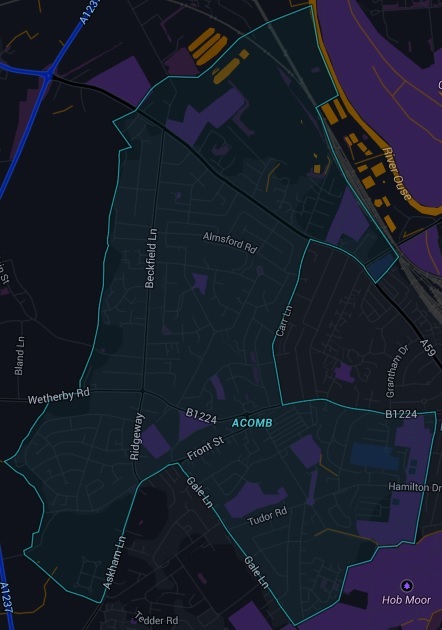Acomb - York
Introduction
Acomb is a suburb within the City of York Unitary Authority, to the western side of York, England. It covers the site of the original village of the same name, which is mentioned in the Domesday Book. It is bordered by the suburbs of Holgate, to the east, Clifton, to the north and Woodthorpe to the south. The boundary to the west abuts the fields close to the A1237, York Outer Ring Road.
Formerly a farming village, Acomb expanded over the centuries to become a dormitory area for workers in heavy industry, such as rail engineering, in the 19th and 20th centuries and more recently for a more diverse workforce. Though it no longer has any large-scale manufacturing, it does have a diverse retail center. There are at least 19 Grade II listed buildings within its boundaries. It was made a Conservation Area in 1975, with the historic area along Front Street and the Green retaining its village character. It is also an Area of Archaeological Importance under the Ancient Monuments and Archaeological Areas Act 1979.
Acomb comprises two wards of the City of York: Acomb and Westfield. At the 2011 Census of England and Wales, it had a population of 22,215, the largest of all areas of the city. There are six primary schools and one comprehensive school. There are also a variety of sporting clubs and one public sports center.
Etymology
Acomb existed before the Norman Conquest, is mentioned in the Domesday Book and was the property of the Dean and Chapter of York Minster. It is the largest suburban area in York. The name is most likely derived from the Old English acum, meaning 'at the oak trees', and indicates that the original village was first established in a heavily wooded area of oaks. In the Domesday book, the name of the village is spelt as both Achum and Acum and during the next one hundred years other spellings can be found, such as Achu, Acun, Akum and Acham. In the 13th century, the spellings Acome, Acorn and Akome can be seen, whilst Akam and Acombe are 15th century. Once printing was established, it enabled the standardisation of spellings to the one seen today.
History
Roman Era
The Roman Emperor Septimius Severus was reputed by some historians to have been cremated in a military funeral near the site of modern day Acomb.
The 10th through 11th Centuries
During the reign of Edward the Confessor, the village of Acomb was designated as a manor. This was known through the entry in the Domesday Book for Acomb, which stated that most of the land of Acomb, including the manor, was in the jurisdiction of the archbishop.
The 12th through 16th Centuries
During the 12th century St. Stephens church was built and measured 52 feet by 25 feet. The original structure would last until 1832, when a new and slightly larger building was erected. At the time of the Norman conquest, Acomb manor was forested and was subject to the king's laws of the woods. To free themselves of these laws, the inhabitants of Acomb paid 19 pounds and 11 pence to King Richard I and 80 pounds to King John. Shortly after King John's reign, the area was deforested. Between 1220 and 1538, the lord of the manor of Acomb was called the treasurer, rather than the archbishop. This change meant that Acomb manor and its church were no longer subject to the jurisdiction of the bishop of the diocese. The treasurer was authorized to hold court, grant marriage licenses, probate wills and issue letters of administration for persons who were dying. The office of treasurer was dissolved when Edward VI came to the throne. In 1547 the Peculiar Court of Acomb was surrendered by the Church in York to the Crown. King James I granted the court to Thomas Newark Esq. in 1609.
The village was typical Anglo Saxon in the 14th century, being made up of local farms and smallholdings. During the reign of Edward III, the king began to raise money from regional traders to fund military ambition on the continent. Many Yorkshire wool merchants played a large part due to their involvement in the establishment of a near monopoly in English wool trade through the exclusion of foreign imports. Edward III made use of the capital made by establishing loan agreements, to which one John de Acomb, a local farmer from the village, made an independent contribution though the venture ultimately failed.
Acomb Grange was the residence of the masters of the medieval hospital of St Leonard, the lands having been given to the Order by Henry II. There are two 15th century timber-framed houses in Acomb.
